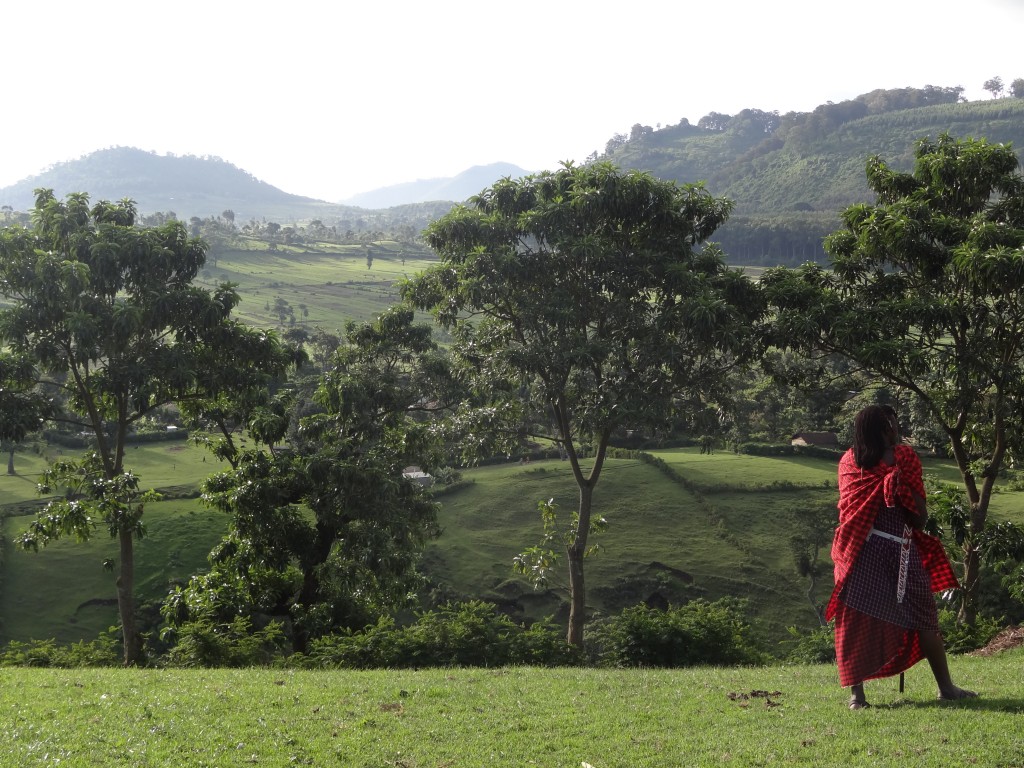
A member of the Maasai tribe served as a guide for Rachel Pellegrino and her classmates as they traveled through the his native village. Pellegrino was struck by the stark contrast of modern technology in the Tanzanian landscape.
Honors anthropology student and Bodenhamer Fellow Rachel Pellegrino spent the summer studying the political, social and natural history of Tanzania in a study abroad program sponsored by the University of Arkansas humanities and anthropology departments. From the top of Mount Kilimanjaro to the depths of the Oldupai Gorge, Pellegrino explored it all during her trip, even spending a little time with the chimps living at the Lake Tanganyika Catchment, Reforestation and Education (TACARE) center founded by the Jane Goodall Institute in 1994. Dr. Goodall will be visiting the University of Arkansas this fall for special lecture titled “Making A Difference” on October 5, 2012.
Jambo!!
I cannot believe I just got back from Tanzania! I traveled abroad with the Natural History of Tanzania program and I will try to give you a taste of everything that I have learned in the past month. Our group was small and by the end of the trip we had all become great friends. This trip was full of mini adventures and it seemed that every day we were going somewhere new and seeing things that we had only known in books.
We flew into Kilimanjaro airport and those were my first steps in Africa. Our first big adventure was climbing Mt. Kilimanjaro. We had learned the importance of the mountain to the Chagga people and we had studied Chagga legends and culture. Our knowledge did not make the climb any easier but it was completely worth it! We stayed the night at the first camp which was the Mandara Huts.
Our next stop was a Maasai village. The Maasai people live in Tanzania and Kenya. They are nomadic people and are recognizable because of the striking red the warriors wear. Before traveling, we had read about the culture and practices of the Maasai, so actually going to a village was a great experience. We decided to walk around which, after our day of hiking yesterday, might not have been the best plan. Our guide was very knowledgeable and this picture of him [above] was taken on our walk. During part of our walk I saw him texting; many people in Tanzania have cell phones as a main mode of communication. The juxtaposition between the technology and the landscape was interesting.
Our next grand adventure took us through the Ngorongoro crater and the Serengeti. This is a picture of me with the crater in the background. We spent three days on game drives and saw animals that to me only live in zoos. There is a reason they call it the “endless plains!” We parked in the middle of the wildebeest migration and they stretched to the end of the horizon. We also saw all of the Big Five! This includes the African buffalo, lion, rhinoceros, elephant, and the leopard. The temperature was in the upper 80s, hot but not too bad. Our guide through the Serengeti was wearing a scarf the whole time. When I asked him why and he responded, “because it’s winter.” We have different ideas of winter.
On the way out, we stopped at Oldupai Gorge. Many hominids have been found here and there are bones everywhere. We were able to just walk around! This picture shows me holding a million year old vertebra…no big deal!
Gombe was our next big spot! We flew from Mwanza to Kigoma, landing on a dirt runway. We piled on a small boat and headed down Lake Tanganyika to the research center there. We spent a good two hours hiking and tracking these chimps and it was not easy. Jane Goodall must have been in amazing shape to have done this everyday! The chimps were amazing to watch though. We were so close yet they just ignored us and went about their business.
On the way back, we stopped at an all male high school. Our group was majority female and the students were excited to meet us. We introduced ourselves and then broke into groups to answer questions. Their English was excellent and they had very thought out questions. These boys were about our age and I could not help comparing them to the high school students in the States. Overall they seemed remarkably similar, but they had much more global knowledge and interest than American students.
After a bit of a delay on the flight back, we made it to the capital, Dar es Salaam. The difference was mind-blowing. We could have been in a big city anywhere. We then took a short ferry ride to Zanzibar. The ferry ride itself was an experience…our group, along with hundreds of people, was trying to get to one place. Once in Zanzibar, we took a tour of Stonetown. The doors were stunning and we learned a bit more about the culture of this area and the significant Arab influence. We got to spend the last couple of days in a nicer lodge, which was greatly appreciated. We had learned about the ecosystem of the coral reef and we got to see it first hand while snorkeling.
It was my first time in Africa and I hope it will not be my last. I came in knowing very little about the culture, natural beauty, and history of the area but now I would be happy to discuss it with anyone. It is so important to acknowledge that there are other cultures in the world and realize that each one has something unique to offer. This trip gave me amazing experiences and a new perspective and I cannot wait to use this knowledge.
Asante Sana!
Rachael Pellegrino


